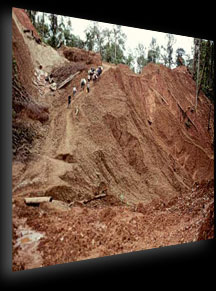 |
Carbon Credits and the Kyoto Protocol |
 |
 The mission of ForestAid.org is to safeguard our future through world wide promotion of a more responsible use of this planets resources.
The mission of ForestAid.org is to safeguard our future through world wide promotion of a more responsible use of this planets resources.
During the seventies and eighties scientific evidence began to indicate complex changes to the global atmosphere, in particular slight increases in the average global temperature, which resulted in a lengthy debate about whether global warming was occurring, and if it was, what the possible reasons might be. By the late 80s sufficient international momentum had developed for discussions to center on the need for an international treaty dealing with climate change, and in 1992 the United Nations established a Framework Convention on Climate Change (FCCC).
Alongside the formal UN treaty process, an International Panel on Climate Change (IPCC) had been set up through which expert scientists assessed all relevant scientific information.
By 1995, after an exhaustive scientific assessment the consensus of the IPCC is that there is a discernible effect of human activities on the global climate. The planet is slowly warming because of increased greenhouse gas emissions, principally from industrial activities.
The key greenhouse gases (% increase) are:
- Carbon dioxide (30%)
- Methane (100%)
- Nitrous oxide (15%)
- Various CFCs
The most predicted impact of increased levels of greenhouse gases are:
- A global temperature increase of around 2 degrees Centigrade by 2100, with significant regional variation around this level
- Rising sea levels
- Adverse and severe weather conditions Globally
- Stronger and more frequent Tornadoes
- Heavy rainfall resulting in more flooding
- Severe and prolonged Drought and Polar ice caps melting
In Japan in 1997 the signatory nations to the Framework Convention adopted the Kyoto Protocol to the Convention.
The Kyoto Protocol, among other things, sets the basis for actions to be implemented by developed countries to meet their greenhouse gas emission targets. The general goal is for developed countries to aim to reduce their greenhouse gas emissions from 1990 levels by at least five percent by 2008-2012.
Logic of carbon credits
 The primary emphasis of the Climate Change Convention and its Kyoto Protocol is to encourage and develop a range of incentives for minimizing those patterns of behavior that lead to increases in the atmospheric concentrations of greenhouse gases. This translates into targeting the major sources of greenhouse gases, for example the transport, mining and other industrial processes, stationary energy and agriculture sectors, as well as developing programs that encourage cleaner technologies and greater efficiencies across all scales, from households to multinational corporations.
The primary emphasis of the Climate Change Convention and its Kyoto Protocol is to encourage and develop a range of incentives for minimizing those patterns of behavior that lead to increases in the atmospheric concentrations of greenhouse gases. This translates into targeting the major sources of greenhouse gases, for example the transport, mining and other industrial processes, stationary energy and agriculture sectors, as well as developing programs that encourage cleaner technologies and greater efficiencies across all scales, from households to multinational corporations.
However, the concentration of carbon dioxide (a primary greenhouse gas) in the atmosphere can also be reduced by using the biological capacity of plants to absorb it. As plants grow they 'breathe' carbon dioxide during the day and release oxygen, and at night this process is reversed. Some of the carbon that is taken in during plant growth is stored (sequestered) in different forms, the most visible being wood in trees, but also including roots. This capacity of plants, and especially trees, to store carbon over time is known as their 'carbon sink capacity'.
The Kyoto Protocol recognises this opportunity and explicitly permits it for a sub-set of carbon sink sources. The Protocol specifies forest-related activities that comply with the definitions of afforestation reforestation and deforestation since 1990 - referred to as Kyoto forests.
This means that forest established after 1990 on land that have never been forested (afforestation) and forest established after 1990 on land that has historically been cleared (reforestation) would qualify for carbon credits. Activities involving replanting areas that were forested in 1990, including naturally occurring native forests would not qualify.
So the Kyoto Protocol will pay for new forests to be planted but will do nothing to save the Rainforests from destruction.